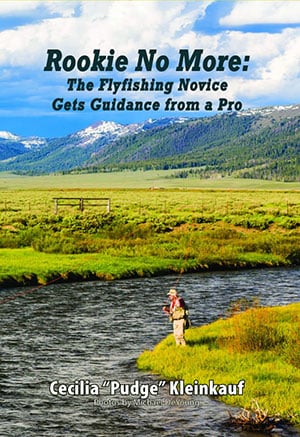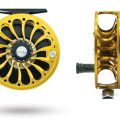Fly Fishing Basics: Lines and Leaders

Mark Sides photo
Question: Can you help me understand the different fly lines and leaders?
Answer: Fly lines and leaders can be puzzling for the novice fly fisher. There are three types of fly lines: floating lines, sinking lines, and sink-tip lines. The floating line is the one that almost everyone buys first, and it is also the line that you will probably find yourself using the most for the remainder of your fly fishing life. That is because we need a line that floats to keep a dry fly drifting along on the surface of the river or lake. At the same time, a floating line enables you to fish in water that is four or five feet deep. No, a floating line won’t sink down that far, but the leader that you attach to the end of the line will, especially if you use a heavy fly or if you put split-shot lead on the leader. Split shot are those little lead balls that you can attached to your leader for more sinkability. More about leaders below.
Fly Lines
Most floating lines are from 80 to 90 feet long. They can be constructed in various ways with different designs or tapers to help the line achieve different casts. The taper that nearly everyone buys first is known as a weight forward taper. That design helps the front end of the line cut through the air as you cast. It doesn’t really weigh any more than the rest of the line, it’s just denser.
Everyone from beginner to expert uses these lines more than any of the others. The first line you purchase should have this taper.
The second type of line is known as a sinking line. This entire line is constructed of material such as lead core that makes it sink under the surface. Obviously, these lines cannot be used for dry-fly fishing. They can also be quite
difficult for beginners to cast and are mostly used for fishing large, deep rivers and lakes, or in saltwater situations.
The third type of fly line is one called a sink-tip line. Here, only some part of the front end of the line is constructed of heavy, sinking material. It is manufactured so that it merges into line that is more like floating line, usually referred to running line. Made for different fishing conditions, sink-tip lines can have sinking material of various lengths (called the sink length), which descend with various speeds (called sink rate). They can have either a short or long front end that can be made to sink very quickly, very slowly, or somewhere in-between.
Fast-sink tips help you to get your fly down very swiftly to where the fish are feeding, such as in a fast-moving river. A slow or intermediate sink tip takes your line down through the various levels in the water column more slowly, such as in a lake. It can be quite confusing to know which one you need for your fishing, so get help from a fly shop or even from the fly line manufacturer itself.
You’ll need to buy a spare spool for your fly reel to carry your extra line(s) so that you can interchange them according to where you are fishing and what you are fishing for. Many people buy a sink-tip line that has about 15 feet of intermediate sinking material on the end, which helps make the line useful in
both lakes and rivers and might eliminate the need to purchase several spare spools for a reel.
Regardless of which type of fly line you purchase, the fly shop will put it on the reel for you. They first tie on some braided Dacron line called backing to give you some extra line just in case your fish pulls out all of your fly line. Then the fly line attaches to the backing and is reeled on top of it. The shop will know how much and what size to put on for different lines and different reels.
Leaders
A leader is a tapered length of monofilament line that is attached to the fly line on one end and to the fly on the other. It “leads” from the fly line to the fly. We use leaders for a couple of reasons: first, because we can’t attach the small fly to the fat fly line (and don’t really want to, because we would spook the fish when the fly was presented); second, because leaders help us deliver the wispy fly to the water more delicately than a fly line could. We want the leader that delivers the fly to the fish to be as invisible as possible.
Generally, people use a leader that is about seven feet long for much of their fishing. Two exceptions are: when you are fishing with a dry fly that is meant to float on the surface of the water; or when you are using a heavy fly or a sink-tip line that drops down quickly in the water.
Dry fly fishing requires a leader that is about nine feet long to help the fly drift more like the real bug, and heavier flies and sink-tip lines require shorter leaders, about four feet long, to help the fly stay below the surface.
If you buy your leaders in the store, you will need to either have what is called a butt loop put on the end of your fly line by the shop, or buy a fly line that has such a loop built right in. Commercially constructed leaders have a corresponding loop on one end so that you can connect the two with what is called a loop to loop connection. A number of online videos show how to make this knot. Some leaders have directions on the back of the package.
If you choose to make your own leaders, you’ll need to learn a knot called the nail knot to connect the back end of the leader to your fly line. Then you’ll need to learn a surgeon’s knot or a blood knot to enable you to attach progressively smaller diameter sections of leader to create the taper that leaders require. Again, the Internet and many fly fishing books have pictures of these knots and instructions on how to tie them. If you’re taking a fly fishing class, your instructor will likely teach you the knots.
Whether commercially made or hand tied, leaders have parts. The rear part of the leader that connects to the fly line is called the butt. It tapers down to a middle section and then on to the end part called the tippet. The tippet connects directly to the fly. The size of the tippet will depend on what size of fly you are using and what size of fish you plan to catch. If you’re going trout fishing, then it is likely that your leader is tapering down to about 6-pound test in breaking strength. If you are fishing for steelhead or red-fish, your leader will more likely be tapering to 10 or even 12 pound test, because these are larger fish. Commercial leaders give you the pound test of the tippet right on the package. The spools of monofilament that you will use for leader construction to make our own leaders will have it written on the spool. I use Ultragreen monofilament made by Maxima to make my leaders.
Fly fishing has a rather complex formula for determining the diameter of monofilament material that you’ll hear people refer to when talking about their leader. Known as the X-system or X-formula, this system gives you the diameter of tippet sizes and matches it with the size of flies to use. As you get more experienced at fly fishing, you can memorize it, but just using the pound-test numbers, which everybody knows, will do fine when you are learning.
Losing a fly in the bushes, or getting broken off by a fish will soon make you realize that the tippet section of your leader is getting shorter and shorter and needs repair or replacement. If you make your own leaders, you’ll use the blood or surgeon’s knot to add a new tippet to make the leader the correct length again. If you don’t know either of those knots, then you’re wise to learn one or the other so you can add tippet to the end of a commercial leader when you need it. (The surgeons knot is the easier of the two, but the blood knot is usually thought to be stronger.
Here again, the internet can be of help.) Be sure to carry either extra commercial leaders or spools of Ultragreen Maxima monofilament in sizes 6-12 in your fishing vest so you can make repairs when needed.












